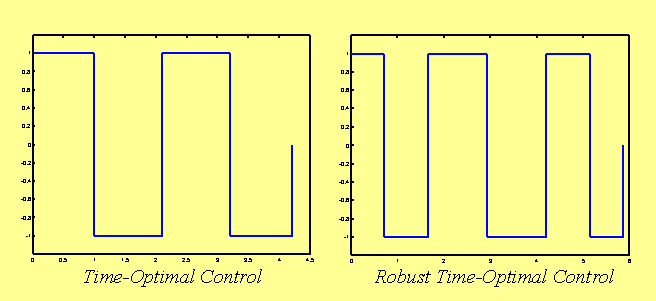Robust Time Optimal Control
Introduction
Minimum time control of structures undergoing rest-to-rest maneuvers with zero residual energy is of relevance for applications such as hard disk drives, cranes, flexible arm robots etc. The bang-bang time optimal control is very sensitive to modeling errors. This motivates the development of a technique to decrease the sensitivity of the bang-bang controller to modeling errors.
In this article, the design of the time optimal control is posed as a parameter optimization
problem by parameterizing the bang-bang control profile in terms of the switch and maneuver time.
A Java Applet is provided to illustrate the
time-optimal and robust time-optimal control.
The time optimal control for the system

is parameterized as

The control profile has to satisfy the constraint
 ,
,
the boundary conditions
 ,
,
and minimize the cost function
 .
.
Errors in estimated values of the damping and natural frequency of the system can result in significant residual vibrations. The control profile can be desensitized to modeling errors by additional switches in the control profile. The additional constraints in the optimization problem are derived by requiring the filter which generates the time-optimal control to place multiple zeros at the nominal location of the poles of the system. The Time-Optimal and the Robust Time-Optimal Control profiles are illustrated below.
 .
.
Details of the development and analysis of results can be found in the materials cited in the section on references shown at the bottom of this page.
Below is an Applet which illustrates the different control profiles. The spring stiffness can be chosen by using the rightmost drop-down list. The other drop-down list allows the selection of the control profile. The Start button starts the simulation. The Stop button can be used to stop the simulation at any point in time. Before selecting a new control profile or spring stiffness, the simulation must have stopped.
The work presented in this article has been described in more detail in the following publication:
- Singh, T. & Vadali, S. R. 1994. Robust Time-Optimal Control: Frequency Domain Approach. Journal of Guidance, Control and Dynamics, 17(2), 346-353.
- Singh, T. 1996. Effect of Damping on the Structure of the Time-Optimal Controllers. Journal of Guidance, Control and Dynamics, 19(5), 130-134.
- Liu, S-W., & Singh, T. 1997. Robust Time-Optimal Control of Nonlinear Structures with Parameter Uncertainties. ASME Journal of Dynamics Systems, Measurement and Control, 119(4), 743-748.